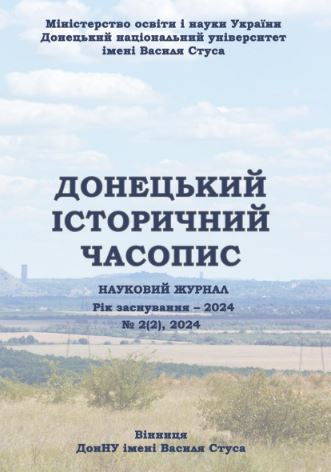The traits of traditional mentality in the worldview of the industrial workers of Donechchyna in the second half of the 19th – early 20th century
DOI:
https://doi.org/10.31558/3083-5771.2024.2.3Keywords:
history of the Donetsk region in the second half of the 19th – early 20th cen¬turies, workers of industrial enterprises, worldviewAbstract
The article highlights and analyzes the features of the traditional mentality in the worldview of the workers of the Donetsk region in the late 19th and early 20th centuries. The research optics of the publication also allowed us to highlight the processes of mental transformations and refute the thesis characteristic of the Soviet discourse about the formation of the working class already in the second half of the 19th century. When working on the problem, general scientific methods of analysis and synthesis were used, which contributed to the isolation of specific worldview imperatives, analyze them and form conclusions. Historical-genetic, historical-comparative and historical-typological methods were used when working with scientific literature, sources, comparing and contrasting the worldview foundations of traditional and industrial society. The study really corresponds to the scientific principles of historicism, scientificity and objectivity. The worldview principles characteristic of the workers of the region are considered specifically and historically in accordance with the realities of the development of the Donetsk region in the second half of the 19th – early 20th centuries.
The study of sources and scientific literature with the use of the specified scientific tools allowed us to draw conclusions about the duration of the preservation of traditional features of the worldview among the workers of industrial enterprises of the region. This was manifested in the preservation of ties with the rural community, a number of work shifts on holidays and in mining fields. Providentialism, fatalism, and belief in supernatural spirits, characteristic of traditional society, remained characteristic of the workers. In social relations, the workers preferred shortterm ties to create workers’ artels, transferring models of behavior with landowners to relations with the administration of enterprises.
The conclusions formed can expand and deepen knowledge of the history of the workers of the Donetsk region in the second half of the 19th – early 20th centuries, actualize the mental dimension of their creation, which is one of the most difficult in the process of creation and interpretation.
The presented publication does not exhaust the research topic, which can be developed in the direction of studying such aspects as the marriage of workers, family practices, raising children, religiosity and its transformation.
References
Biletska, V. (1927). Shakhtarski pisni [Coal-Mining Songs]. Etnohrafichnyi visnyk, 5, 50–71 [in Ukrainian].
Diedush, Ye. (2016). Personazh «Shubin» yak refleksiia rehionalnoi identychnosti ukrainskoho Donbasu [The character «Shubin» as a reflection of the regional identity of the Ukrainian Donbas]. Istoryko-kraieznavchi doslidzhennia: tradytsii ta innovatsii. Sumy: SDPU, 2, 170–173 [in Ukrainian].
Dubyna, К. & Hurzhii, І. (1967). Istoriia Ukrainskoi RSR [History of the Ukrainian SSR]. (T. 1). Kyiv: Naukova dumka [in Ukrainian].
Fenin, O. (1938). Vospominaniya inzhenera. K istorii obshchestvennogo i khozyaistvennogo razvitiya Rossii (1883–1906 gg.) [Memories of an engineer. On the history of social and economic development of Russia (1883–1906)]. Praga [in Russian].
Friedgut, Th. (1994). Iuzovka and Revolution 1869–1924 (Vol. 2). Princeton: Princeton University Press.
Kulchytskyi, S. & Yakubova, L. (2015). Donechchyna i Luhanshchyna u XVII–XXI st.: istorychni faktory y politychni tekhnolohii formuvannia osoblyvoho ta zahalnoho u rehionalnomu prostori [Donetsk and Luhansk Regions in the 17th–21st centuries: Historical Factors and Political Technologies of the Formation of the Special and the General in the Regional Space]. Kyiv: Instytut istorii Ukrainy NAN Ukrainy [in Ukrainian].
Kulikov, V. (2019). Pidpryiemstva y suspilstvo v zavodskykh i shakhtarskykh poselenniakh Donbasu ta Prydniprovʹia v 1870–1917 rr. [Enterprises and society in the factory and mining settlements of Donbas and the Dnieper region in 1870–1917]. Kharkiv: Vydvo KhNU imeni V. N. Karazina [in Ukrainian].
Kuromiia, H. (2002). Svoboda i teror u Donbasi: Ukrainsko-rosiiske prykordonnia, 1870–1990-i roky [Freedom and Terror in Donbas: The Ukrainian-Russian Borderland, 1870–1990s]. Kyiv: Vydavnytstvo Solomii Pavlychko «Osnovy» [in Ukrainian].
Mekhmandarov, S. (1905). Zabolevaemost rabochikh yuga Rossii [Morbidity of workers in the south of Russia]. Vestnik fabrichnogo zakonodatelstva i professionalnoi gigieni. Sankt-Peterburg: Tipografiya tovarishchestva «Obshchestvennaya polza» [in Russian].
Otzemko, O., & Piatnytskova, I. (2022). Promyslovyi postup Donbasu za memuaramy inozemtsiv (druha polovyna ХІХ – pochatok ХХ st.) [Industrial progress of Donbass ac-cording to the memoirs of foreigners (second half of the 19th – beginning of the 20th centuries)]. Eminak: naukovyi shchokvartalnyk, 3(39), 53–66 [in Ukrainian].
Portnova, T. (2016). Liubyty i navchaty: selianstvo v uiavlenniakh ukrainskoi intelihentsii druhoi polovyny ХІХ stolittia [To Love and Teach: Peasantry in the Representations of the Ukrainian Intelligentsia of the Second Half of the 19th сentury]. Dnipropetrovsk: Lira [in Ukrainian].
Prysiazhniuk, Yu. (2007). Ukrainske selianstvo Naddniprianskoi Ukrainy: sotsiomentalna istoriia druhoi polovyny XIX – pochatku XX stolittia [Ukrainian рeasants of the Dnieper Ukraine: sociomental history of the second half of the 19th – early 20th centuries]. Cherkasy: Vertykal [in Ukrainian].
Riss, P. (1905). Uglekopi [Coal miners]. Vestnik fabrichnogo zakonodatelstva i professionalnoi gigieni. Sankt-Peterburg: Tipografiya tovarishchestva «Obshchestvennaya polza», 3, 136–161 [in Russian].
Shliakhov, O., Donik, O. (2020). Praktyka i struktura dozvillia robitnykiv Ukrainy v konteksti industrialnykh transformatsii kintsia ХІХ – pochatku ХХ st. (za materialamy Katerynoslavskoi hubernii [Practice and structure of leisure of Ukrainian workers in the context of industrial transformations of the late 19th – early 20th centuries. (based on materials from the Ekaterinoslav province)]. Ukrainskyi istorychnyi zhurnal, 1, 45–62 [in Ukrainian].

